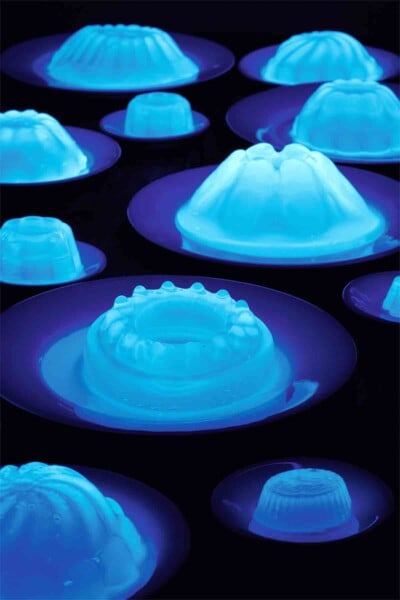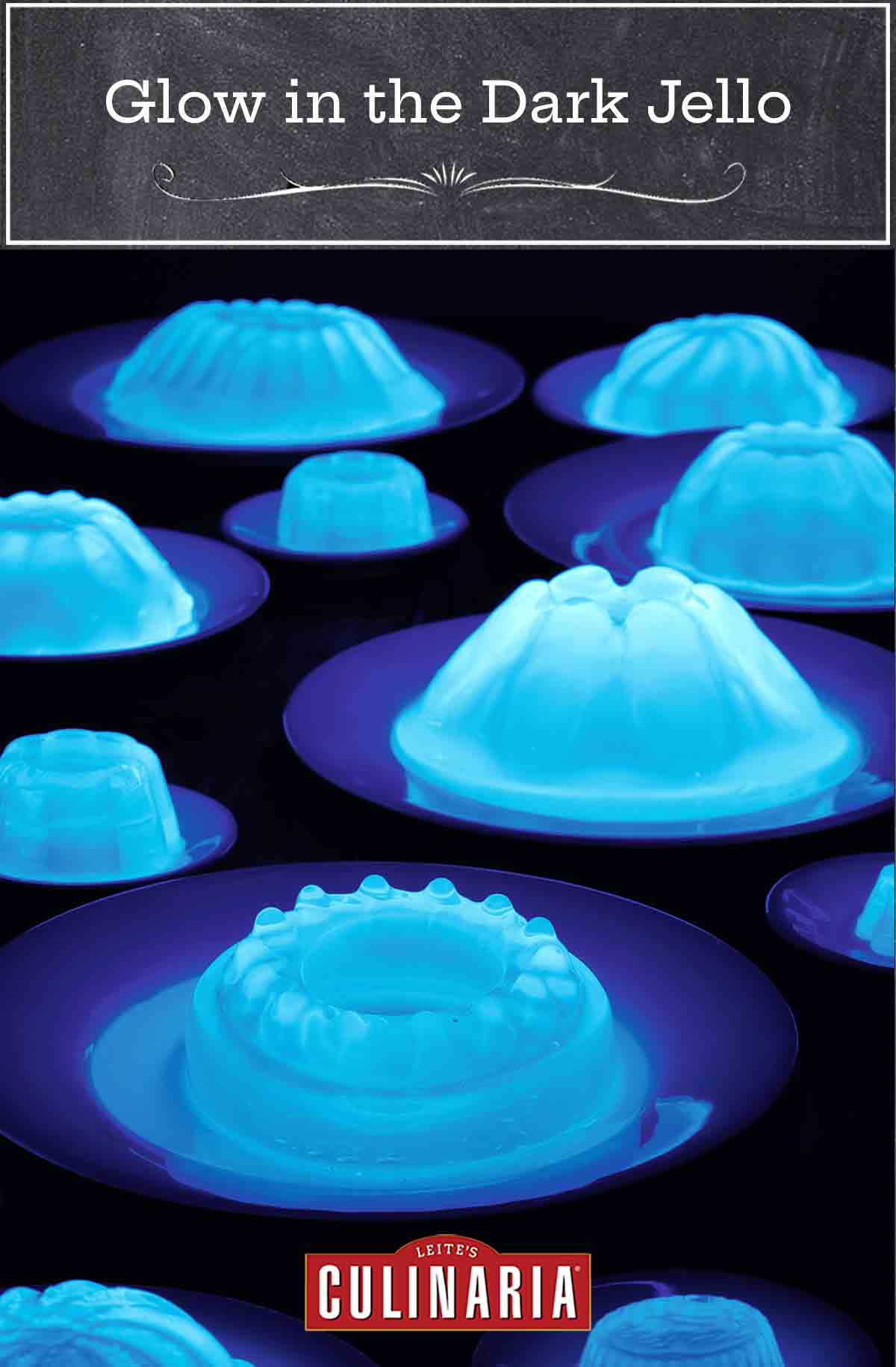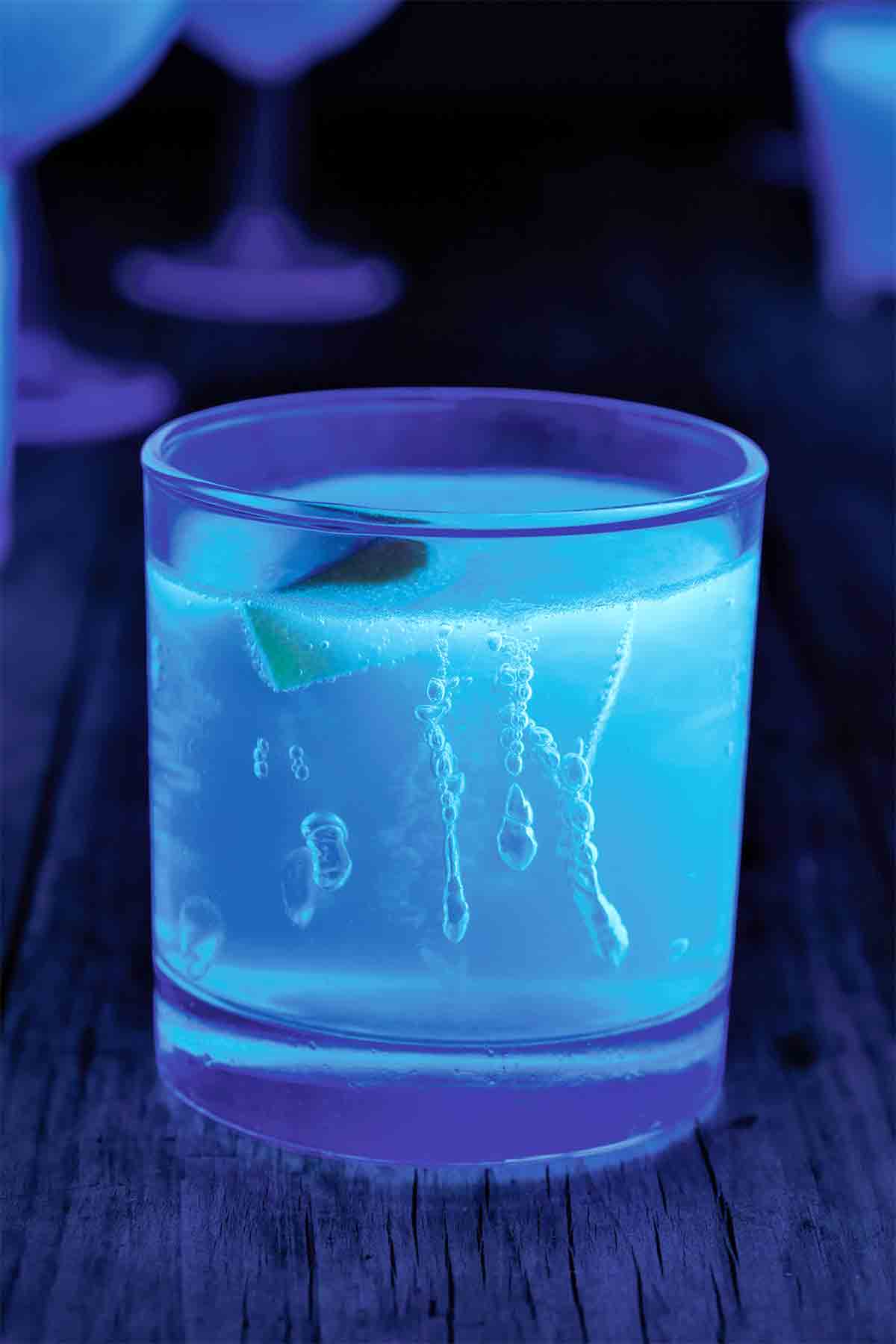
Rest assured, the spirits summoned for these ghostly glow in the dark Jello shots hail from a bottle, not the supernatural. It’s an essential party trick that’s part science project, part Halloween decor, part nifty excuse to knock back some Jello shots. And mostly gin and tonic. Black lights required.
Common Questions
So why are Jell-o molds radiating pale blue? The answer is that quinine—the bitter flavoring in tonic water—glows under a UV fluorescent light, which can easily be found at hardware stores or online. The author suggests, for sheer shock value, letting the gelatin sit on the table with the lights on without drawing undue attention. Then place your fluorescent bulb as close to the Jello as you can before you switch off the lights.
Want to serve this specter of a spectacle to kids or teetotallers? The author of the recipe swears it works just as well when made without the gin. Just substitute tonic water for the gin as noted in the recipe below.
This glow-in-the-dark Jello recipe works in shot form as well as a single large mold–a fact that we can personally vouch for. You could also opt for tiny brioche molds, teacups, or, even a rocks glass.
Not a fan of gin? Go ahead and swap in vodka for the gin. It will work just as well.
Write a Review
If you make this recipe, or any dish on LC, consider leaving a review, a star rating, and your best photo in the comments below. I love hearing from you.–David

Glow in the Dark Jello
Equipment
- Fluorescent UV light; gelatin molds or Bundt pans of any size or shot glasses or anything you can think to use as a mold or just use a baking dish and some spooky-shaped cookie cutters
Ingredients
- 2 packages sheet gelatin, (enough to set 2 quarts firmly—usually about 50 percent more than listed on the package)
- 2 cups decent gin, (if you don’t want to serve alcohol, you can substitute chilled tonic water)
- Juice of 3 large limes or lemons
- 1 1/2 quarts (6 cups) tonic water, chilled
- Mild vegetable oil
Instructions
- Cut the gelatin sheets into small pieces using scissors and place them in a large heatproof bowl. Pour 1 cup gin over the gelatin and let it rest until the gelatin starts to soften, about 10 minutes.
- Place the bowl of boozy gelatin in the microwave and heat on high power for 1 1/2 minutes or place the bowl over but not touching a saucepan of simmering water. Stir until the gelatin has completely dissolved. Do not let the gelatin come to a boil. Remove from the heat.
- Stir the remaining gin into the gelatin along with the lime or lemon juice. Then add the chilled tonic water, pouring it in as slowly and carefully as you can to keep it from fizzing. You want to lock in all those bubbles so they have a stunning effect in the Jello.
- Slick your gelatin molds or shot glasses or whatever containers you intend to use with a paper towel soaked with vegetable oil. Pour the gin and tonic mixture—hold the mixture low to the molds and be sure to pour slowly and carefully to minimize bubbling—into your gelatin molds or glasses or even into a baking dish (you'll later need to cut the Jello into cubes or shapes using a knife or spooky-shaped cookie cutters). Place in the fridge to set for about 6 hours.
- Now’s the fun part. Serve it under a fluorescent UV light. The darker the atmosphere, the better the effect, so it's best at night, with the lights turned out and the UV bulb as close to the Jellos as possible!

Nutrition
Nutrition information is automatically calculated, so should only be used as an approximation.
Recipe Testers’ Reviews
My kids (ages 25 and 27) were totally jazzed about this glow-in-the-dark Jello. Having their experience at making Jello shots behind me, I forged ahead. I split the recipe into 2 batches, since I don’t like gin, and they don’t like vodka. I followed the directions as written, and used lime juice for the vodka and lemon for the gin.
I poured the Jello into waxed Dixie cups, like the dentist uses, and allowed them to set. That way there’s no oily taste from the molds, and you just peel them back to eat.
After bringing them out on the deck, where everyone was standing by with black lights, I can say the kids and adults alike LOVED this one. The Jello shots not only glowed, they literally lit up the night. My husband has an industrial-size black light for his work, so we got to really see what these can do.
Who needs outdoor lighting when you could almost read by the light these gave off? We all agreed the texture is good, but the alcohol with the tonic water makes for a little bitter aftertaste.
We all found that 2 cups of alcohol is overwhelming. I don’t drink often, so I thought that might be just me, but they all agreed. I only used 1 cup of gin in that batch, and they found it much more palatable.
I will certainly do this one again, but will decrease the alcohol content and maybe add something to sweeten it to offset the bitterness. All in all, totally fun.













Just signed up for your emails after this first one. I’m wondering why it took me so long, I’ve been coming to your pages since ’04 and had no idea how many awe-inspiring articles you have. Mind you, I’m a begining cook, and after my personal economic downturn I’m learning there’s life after business lunches and dinners to go. Very happy to discover how much fun this can be.
And we’re very happy to have you, Beveanne. Many thanks for your kind words. We’re honored to be a part of your learning curve. And yes, it’s a continual process, this discovery thing…so we try to have as many laughs along the way as we can muster!
Okay, that’s crazy. But COOL!
Yup. We think so, too, Mary!
For American readers: One envelope of gelatin will firmly set 2 cups of liquid. Therefore for about 8 cups of liquid in the recipe, you’ll need 4 envelopes of gelatin; though you may wish to err on the side of caution and add a bit more.
More detail: To be technical about it, the way the recipe is written you can’t be exactly sure about how much gelatin to use without trying it. Gelatin sheets typically come in three strengths: gold, silver and bronze. To complicate the matter, sheets can vary in size, too. What you really need to know is the strength and weight of the gelatin, which isn’t specified.
One envelope of gelatin can be anywhere from 3 – 5 sheets. For gelatin convertion, try 1 env. to 3-1/2 sheets as a starting point.
Many thanks for clarifying something that’s a little tricky and comes with experience, John. Appreciate it.
Thanks for the explanation! I was wondering if any Americans have tried this yet and have it down to an exact science? I am planning to bring jello shots to a party on Saturday and I dont want to mess it up at the last minute 🙁 Super excited about this though… Does it matter which flavor? Thanks!!!!
Amanda, I don’t believe it matters what flavor. What’s paramount, though, is that you have a UV fluorescent light. And now we’re sorta vicariously excited for your party, so do let us know how it goes!